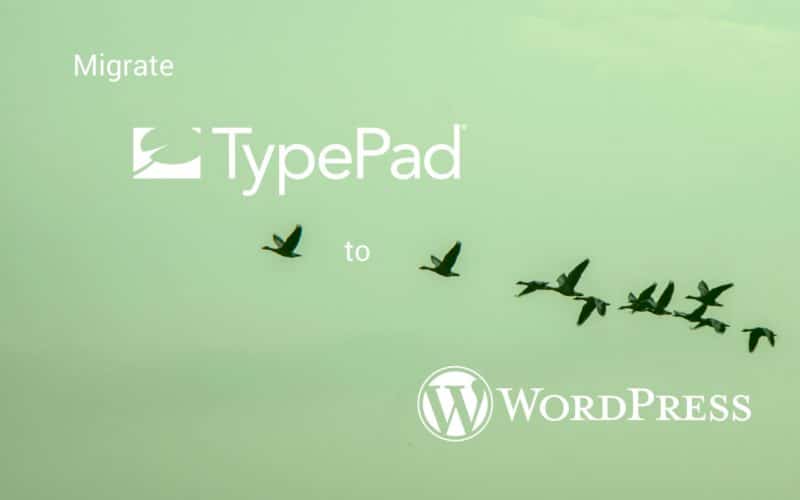I helped a friend move his blog from Typepad to self-hosted WordPress recently. And I just wanted to spell out what I did for anyone else who might need to do this same thing. It can be fairly advanced, but with the help of some specific instructions, it can be done without too much effort. This is especially true if the blog is not too large, or at least doesn’t have too many images in the posts (this one’s relatively new and doesn’t rely heavily on images, so it worked great).
- I set up the new WordPress install on a new account at Hostgator. But I wanted the blog to continue functioning on Typepad until everything was ready to go on the new site. So we didn’t change the nameservers for the domain at his current registrar.
- But you need a way to work with the WP site, so I used these instructions from Hostgator on how to change your host’s file so that my computer would go to the new WordPress site when I typed the domain in the browser. Also, 1 thing that is not on there: you’ll also want to include the ftp variation: “ftp.domain.com” after the “www.domain.com” one so you can log in via ftp. As you’re going along, if you need to access your site at Typepad through your domain, all you have to do is take that line back out of the host’s file and save it again. I kept the hosts file open throughout this process so I could switch back and forth as needed.
- Now use this article from Typepad’s site to export your blog, then import it into the new WordPress site. It doesn’t include an additional step that more recent versions of WordPress require, which is where you’re prompted to install a plugin to import from Typepad. It’ll pretty much walk you through the process.
- Now, if you won’t want to lose any SEO “juice” (aka ranking), you’ll want to setup the permalink structure, just like it was on Typepad. My friend’s blog had the folder “my-blog” after the domain, so I used this permalink structure in WordPress under Settings>Permalinks:
/my-blog/%year%/%monthnum%/%postname%.html - Step 3 imports all the text and embedded videos, etc. But it won’t move the images over to you. I found this article from FolioVision that tells you how to download all the images. You’ll want to skip down and just do step 7 & maybe 9 (there doesn’t appear to be an 8). But ignore the rest, because they did it the hard way. Since we’ve exactly mimicked the original permalink structure, a lot of the stuff they say to do is frivolous.
- Once you’ve downloaded the images, you can go 2 routes: 1) try to closely mimic the image paths as well, or 2) just relocate them entirely. Neither option will keep the links on Google image search intact, because Typepad does not include the image extension (eg. “image.jpg” is just “image” on Typepad), but the actual files have the extension so WordPress doesn’t see the URL, but can’t find the file. That article from FolioVision tells you how to do #2 in step 9. I opted to try to mimic the current link structure, hoping the links would still work, which they didn’t, but it did make the redirects and much more simple since I didn’t have to change the location of the file plus add the appropriate extension on the end.
- So the next step is to upload the images. I found them inside the folder I had created to download the site to in step 5, then inside these subfolders: www.domain.com.a – this reflects where Typepad stored them. So to most closely mimic Typepad, I just created a folder called “.a” in the public_html root of the site then uploaded them all there. FTP is easiest and works normally if you’ve included it in your host’s file, as mentioned before. This means that WordPress will have their location correct (because it’s the same as it was on Typepad), once you switch the domain over, except that they need the image extension added.
- From there it was just a matter of adding the appropriate extension to each image. I did this by copying the filename from each image on my hard drive, then pasting them into both the “Search Pattern” and “Replace Pattern” fields of the plugin Search Regex. Then I’d remove the file extension (.jpg, .gif, or .png) from the first field, then click the “Replace & Save” button. What this does is find that image name in the WordPress database where everything is stored, then replaces it with the exact same name, but with the proper image extension on the end.
- Luckily there weren’t too many images, so it didn’t take particularly long. Just to check, you can search for the folder (“/.a/” in my case) then scan through the results to make sure all the image files have the image file extension on the end, but not more than one. If you hit the “Replace & Save” button twice, they’ll have 2 extensions like “.jpg.jpg” on the end. You’ll need to correct that doing another replace and save where the search is “.jpg.jpg” and the replacement is “.jpg”.
- Lastly, if you do want those images to show up on Google, you’ll need to set up some redirects with a plugin like Redirection. It’s fairly similar to Search Regex, except instead of replacing stuff in the database, you’re just telling Google and the browsers of users who click the old links to the images, where to go now since the old images aren’t there anymore. So you’ll just put something like “http://www.domain.com/.a/6a0133ee46600d970b01538dd8808d970b-pi” in the “Source URL” field, and “http://www.domain.com/.a/6a0133ee46600d970b01538dd8808d970b-pi.png” in the “Target URL” field then click “Add Redirection.” You’ll need to do this for each image. But again this is only so people clicking Google/Bing image search results will still get to your images, so it may not even be worth doing.
That’s it! And step 10 is pretty optional. From there it’s just a matter of getting the right theme, and add the plugins you want/need to add social networking, etc. to your old blog that has been given a new lease on life with WordPress world’s greatest blogging, and general web platform!







0 Comments